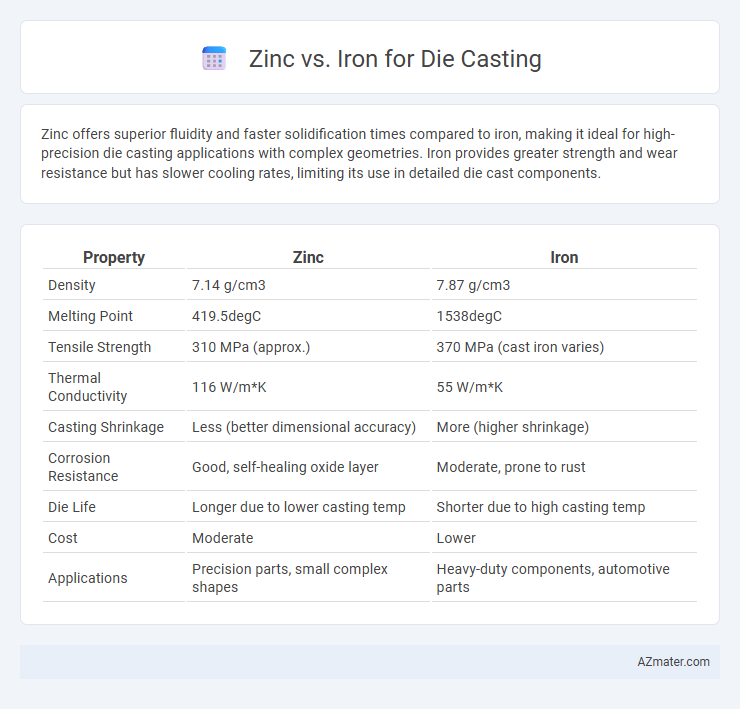Zinc offers superior fluidity and faster solidification times compared to iron, making it ideal for high-precision die casting applications with complex geometries. Iron provides greater strength and wear resistance but has slower cooling rates, limiting its use in detailed die cast components.
Table of Comparison
| Property | Zinc | Iron |
|---|---|---|
| Density | 7.14 g/cm3 | 7.87 g/cm3 |
| Melting Point | 419.5degC | 1538degC |
| Tensile Strength | 310 MPa (approx.) | 370 MPa (cast iron varies) |
| Thermal Conductivity | 116 W/m*K | 55 W/m*K |
| Casting Shrinkage | Less (better dimensional accuracy) | More (higher shrinkage) |
| Corrosion Resistance | Good, self-healing oxide layer | Moderate, prone to rust |
| Die Life | Longer due to lower casting temp | Shorter due to high casting temp |
| Cost | Moderate | Lower |
| Applications | Precision parts, small complex shapes | Heavy-duty components, automotive parts |
Introduction to Zinc and Iron in Die Casting
Zinc and iron are prominent materials used in die casting due to their distinct metallurgical properties and performance characteristics. Zinc offers excellent fluidity, making it ideal for intricate die cast components with thin walls and fine details, while iron provides superior strength and wear resistance suited for heavy-duty applications. The choice between zinc and iron in die casting hinges on balancing factors like mechanical strength, corrosion resistance, thermal conductivity, and production cost.
Material Properties: Zinc vs Iron
Zinc offers excellent corrosion resistance, low melting point (419.5degC), and superior dimensional stability, making it ideal for complex die casting with fine detail. Iron, with a higher melting point (around 1538degC) and greater tensile strength, provides enhanced durability and wear resistance but is less suitable for intricate shapes due to shrinkage and machining requirements. The choice between zinc and iron in die casting depends on balancing lightweight, precision, and corrosion protection versus strength and structural integrity.
Melting Points and Process Temperatures
Zinc has a melting point of approximately 419.5degC (787.1degF), significantly lower than iron's melting point of around 1538degC (2800degF). This lower melting point makes zinc alloys ideal for die casting processes operating at temperatures between 370degC and 430degC, enabling faster cycle times and reduced tool wear. Iron, used primarily in sand casting or investment casting, requires much higher process temperatures, limiting its suitability for traditional die casting methods.
Tooling and Mold Life Comparisons
Zinc alloys in die casting offer superior tooling life compared to iron molds due to their lower melting points, reducing thermal stress and wear on molds. Iron tooling exhibits higher resistance to mechanical erosion but suffers from more frequent maintenance because of prolonged cycle times and higher operational temperatures. Overall, zinc die casting molds provide enhanced longevity and efficiency, making them ideal for high-volume production with complex geometries.
Mechanical Strength and Durability
Zinc alloys in die casting offer superior ductility and corrosion resistance compared to iron, making them ideal for components requiring moderate mechanical strength with enhanced durability against environmental factors. Iron, particularly in ductile cast iron form, provides significantly higher tensile strength and wear resistance, suitable for heavy-duty applications where load-bearing capacity and structural integrity are critical. The choice between zinc and iron depends on balancing the requirement for lightweight, corrosion-resistant parts versus strength-intensive, long-lasting components in die casting processes.
Corrosion Resistance: Zinc vs Iron
Zinc exhibits superior corrosion resistance compared to iron due to its ability to form a protective oxide layer that prevents further oxidation. Iron, on the other hand, is more prone to rust and corrosion when exposed to moisture and air, often requiring additional coatings or treatments for protection. This inherent resistance makes zinc alloys highly suitable for die casting applications in environments where corrosion is a critical factor.
Surface Finish and Aesthetic Outcomes
Zinc die casting provides superior surface finish with finer detail resolution and smoother aesthetics compared to iron, ideal for decorative components and high-precision applications. The lower melting point of zinc reduces thermal stress, minimizing surface defects and improving overall visual quality. Iron castings often result in rougher surfaces requiring extensive post-processing, making zinc a preferred choice for applications where appearance is critical.
Cost Efficiency in Production
Zinc offers superior cost efficiency in die casting due to its lower melting temperature, resulting in reduced energy consumption and shorter cycle times compared to iron. Zinc's excellent fluidity and faster solidification improve mold filling and productivity, minimizing scrap rates and operational costs. Iron, while stronger, involves higher material and processing expenses, making zinc the preferred choice for high-volume, cost-sensitive die casting applications.
Typical Applications for Zinc and Iron Die Cast Parts
Zinc die cast parts are commonly used in automotive components, electrical fittings, and consumer electronics due to their excellent dimensional accuracy and corrosion resistance. Iron die cast parts typically serve in heavy-duty machinery, engine blocks, and industrial tools because of their superior strength and wear resistance. The choice between zinc and iron depends on application requirements such as mechanical strength, weight, and environmental exposure.
Sustainability and Environmental Considerations
Zinc die casting offers superior recyclability and lower energy consumption compared to iron, significantly reducing its environmental footprint. Iron casting generates higher greenhouse gas emissions due to the intense heat required for melting and prolonged production cycles. Choosing zinc supports sustainable manufacturing practices by promoting material reuse and minimizing carbon emissions in die casting processes.

Infographic: Zinc vs Iron for Die Casting
 azmater.com
azmater.com